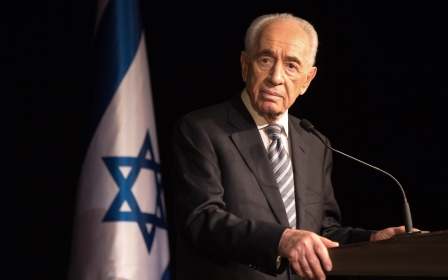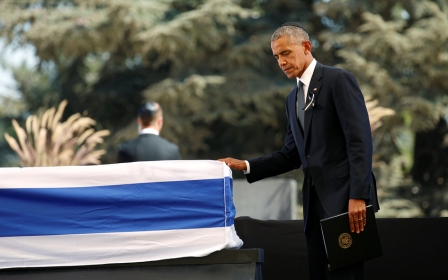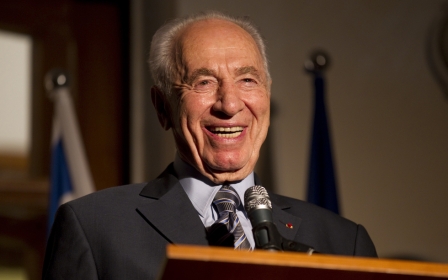Peres's nuclear legacy: Israel's reactors reaching end of life

Upon his death on Wednesday, the Israel Atomic Energy Commission (IAEC) released a photo of the late Shimon Peres walking in the avenue inside the compound leading to the dome of Israel’s nuclear reactor in Dimona.
It was IAEC’S homage to the statesman who, more than anyone else, pushed 60 years ago for the Jewish state to have the capabilities to produce the ultimate weapons which would ensure its survival and give the country self-confidence.
Peres’ nuclear vision and legacy still live on and were evident this week also at the annual General Assembly of the International Atomic Energy Agency (IAEA) convened in Vienna. For the first time, the IAEC had a stall exhibiting its nuclear achievements. Almost.
In the display there was, of course, no reference or even hint for the main reason why Peres and his mentor, Israel's first prime minister, David Ben Gurion, worked hard to have a nuclear reactor that would produce fissile materials for nuclear bombs.
A nuclear opening
Still, amid the secrecy which surrounded Israeli nuclear policy for years, even the modest exhibition at IAEA headquarters showing the civilian nuclear by-products of the reactor at IAEC was a sign of its relative nuclear openness.
This self-confidence is rooted in the dramatic changes underway in the Middle East. The Shia-Sunni schism expressed by the animosity between Saudi Arabia and Iran, the rise and decline of Islamic State (IS) group, the collapse of Libya, Yemen, Iraq and the Syrian civil war – all of these improved the secret military and intelligence cooperation between several Arab states led by Egypt and Israel.
One important result of this development occurred at the IAEA general conference. For the first time in three decades, the Arab League headed by Egypt did not table a draft resolution condemning Israel for its nuclear policy.
Past drafts, all titled “Israel’s nuclear capabilities,” called upon Israel to open Dimona for IAEA inspection to join the Non Proliferation Treaty (NPT) of nuclear weapons and to establish a nuclear free zone in the Middle East, were never adopted.
This year, however, Egypt refrained from submitting any draft resolution and persuaded the other member states in the Arab Group to follow suit.
No confirmation, no denial
Israel for its part has no intentions to change its opaque and ambiguous policy. Israel neither confirms nor denies whether it has nuclear weapons.
To define the policy in simple terms, one can say that Israel first demands that all Middle Eastern countries, Iran included, recognise it and sign peace treaties, supplemented by security arrangements. Then negotiations on the dismantling of all weapons of mass destruction – chemical, biological and nuclear – can begin; only then, and as a last step, would Israel consider getting rid of its own nuclear weapons and diverting its programme for civilian use. This is a utopian vision that will never become reality.
The director general of IAEC, Brigadier-General Zeev Snir, reiterated this traditional policy in his address to the general assembly by vaguely saying that “the State of Israel has repeatedly underlined its willingness to cooperate with any state in the Middle East, in strengthening security and safety".
Loss of US fuel
Yet some changes are occurring in regard to the two nuclear reactors which Israel has – the one in Dimona and the other one in Soreq, 15 miles south of Tel Aviv.
The Soreq nuclear research centre is a small reactor with a two-megawatt capacity which was given to Israel as a gift by the US in 1958 as part of its ”Atoms for Peace” policy designed by president Dwight Eisenhower. The US also supplied the 93 percent highly enriched uranium to fuel and operate it.
Since the reactor capacity is very small, it is purely for nuclear research and cannot produce fissile materials. It is under IAEA inspection.
Fearing the spread and proliferation of nuclear materials a decade ago, the US government had already decided to take back the 93 percent uranium – which can also be used to produce nuclear weapons - from all the states, Israel included, that benefited from the Atoms for Peace programme.
Since then, in order to save the remained nuclear fuel, the Soreq reactor has been operated partially at a slow pace. But Snir and his advisers recently reached the conclusion that it is inevitable that in a matter of two to three years it will be completely shut down.
Ageing reactors
On the other hand, the IAEC decided to prolong the life of the Dimona reactor, which Israel secretly purchased in 1957 from France. Originally, the reactor capacity was 24 megawatts, but it was reported in the international media that Israel doubled its power to 50 megawatts and maybe even more.
The life expectancy of this type of reactor is 40 years. So the reactor should have had to be shut down in 2003. But French and American nuclear scientists and engineers managed to prolong the durability of this kind of reactor an additional 20 years. That means that theoretically the Dimona reactor will “die” in 2023.
In the meantime, the IAEC experts discovered 1,300 minor cracks and flaws in the reactor core, which is made of heavy cement and iron. Unlike other parts, the core can’t be replaced.
So the IAEC began to closely monitor the problem and, after serious consultations among themselves, and with renowned international nuclear experts, they found a solution that they refuse to reveal. Nevertheless, they have assured the Israeli public that flaws are under control and that the reactor safety is intact. Thus, there is no public or environmental hazard.
According to various estimates and reports by international think-tanks and intelligence agencies, Israel already has a stockpile of between 80 and 200 nuclear warheads of all sorts. So, theoretically, Israel doesn’t need to have the "bomb factory" for its future existence and for deterrence. But Israel can’t allow itself to shut down the facility, which symbolises its power like the long hair of Samson.
Thus Snir and the IAEC recently also decided that, with the right “anti-aging” treatment, the Dimona reactor’s life can be prolonged to the age of 80. In other words, the reactor will continue to operate at least to 2043.
- Yossi Melman is an Israeli security and intelligence commentator and co-author of Spies Against Armageddon.
The views expressed in this article belong to the author and do not necessarily reflect the editorial policy of Middle East Eye.
Photo: Shimon Peres walks through the grounds of Israel's nuclear reactor facility at Dimona (IAEC)
New MEE newsletter: Jerusalem Dispatch
Sign up to get the latest insights and analysis on Israel-Palestine, alongside Turkey Unpacked and other MEE newsletters
Middle East Eye delivers independent and unrivalled coverage and analysis of the Middle East, North Africa and beyond. To learn more about republishing this content and the associated fees, please fill out this form. More about MEE can be found here.





